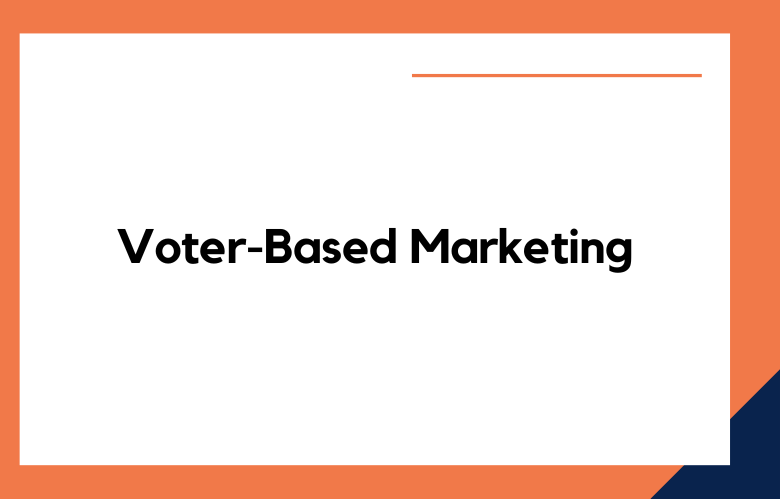Political campaigns have long recognized the importance of targeted marketing, but the advent of big data and machine learning has opened up new possibilities for precision targeting. Voter-based marketing (VBM) is a powerful tool that allows campaigns to leverage data and analytics to identify and engage with the voters most likely to support their cause.
What is Voter-Based Marketing?
Voter-Based Marketing(VBM) for Political Campaigns: Strategies for Targeted Success
At the heart of VBM is the ability to segment voters based on their demographics, interests, and behaviors. By analyzing data such as voting history, social media activity, and consumer habits, campaigns can create a detailed profile of their ideal voter. This information can then be used to develop targeted messaging and outreach efforts tailored to specific voter segments.
For example, a campaign might identify voters who are concerned about healthcare issues and have a history of supporting progressive policies. The campaign could then create targeted messaging and outreach focusing on the candidate’s healthcare platform, highlighting the candidate’s commitment to expanding access to affordable healthcare.
VBM is particularly efficient with digital marketing channels such as social media, email, and online advertising. These channels allow campaigns to reach their target audiences with pinpoint accuracy and track the effectiveness of their efforts in real time.
Navigating the Voting Maze: Effective Strategies for Voter-Based Marketing
Navigating the complex landscape of voter preferences and behaviors is akin to moving through a maze, where understanding and effectively engaging with voters is paramount for political campaigns. Practical strategies for voter-based marketing require a deep understanding of the electorate of advanced data analytics and a tailored approach to communication. Here are some key strategies to effectively navigate this voting maze:
In-depth Voter Segmentation:
Divide the electorate into detailed segments based on demographics, psychographics, voting history, and other relevant factors. This segmentation allows for a nuanced understanding of different voter groups, priorities, and concerns, enabling campaigns to craft messages that resonate personally.
Utilize Advanced Data Analytics:
Employ sophisticated data analytics tools to mine voter data, social media interactions, and engagement metrics. This analysis can reveal insights into voter sentiments, trending issues, and the effectiveness of various outreach efforts, guiding strategic decisions and resource allocation.
Personalized Voter Engagement:
Tailor communication to the individual sible, using data insights to inform the message’s content, tone, and medium. Personalized emails, targeted social media ads and customized direct mail can increase engagement and influence voter behavior.
Omnichannel Communication Strategy:
Develop an integrated communication strategy that spans multiple channels, including digital platforms, traditional media, and grassroots outreach. Consistency across channels reinforces the campaign’s message and increases its reach and impact among diverse voter segments.
Emphasize Local Issues and Representation:
Highlight local issues and representation in campaign messaging to establish a connection with voters at the community level. Showing awareness and commitment to local concerns can enhance voter trust and support.
Leverage Social Proof and Influencers:
Utilize endorsements from local leaders, influencers, and community members who resonate with target voter segments. Social proof can lend credibility to the campaign and encourage broader engagement through a relatable and trusted voice.
Get Out the Vote: Unlocking the Power of Voter-Based Marketing
Voter turnout is the lifeblood of any democracy, and political campaigns always look for ways to encourage more people to exercise their right to vote. One powerful tool in their arsenal is voter-based marketing (VBM), which leverages data analytics and targeted marketing to engage and mobilize specific voter segments.
The key to effective VBM is a deep understanding of the voter base. Campaigns must collect and analyze voter demographics, behavior, and preference data to identify each voter segment’s unique characteristics and needs. This information can help to create tailored messaging and outreach efforts that motivate voters to turn out on election day.
Winning Hearts and Minds: Harnessing Voter-Based Marketing for Political Success
In today’s political landscape, campaigns must find creative and effective ways to reach and engage with voters. Traditional forms of advertising and outreach are no longer enough to capture the attention and support of the electorate. The solution lies in Voter-Based Marketing (VBM), a data-driven approach that enables campaigns to tailor their messaging and outreach efforts to specific groups of voters.
VBM leverages advanced data analytics to create detailed profiles of voters based on their demographics, behaviors, and preferences. This information is then used to segment voters into groups based on shared characteristics, allowing campaigns to create targeted messaging that speaks directly to the concerns and values of each group.
The Secret Weapon: Voter-Based Marketing Demystified
Political campaigns have become increasingly sophisticated in recent years, leveraging advanced data analytics and marketing techniques to gain a competitive edge. One of the most powerful tools in their arsenal is Voter-Based Marketing (. This data-driven approach enables campaigns to create highly targeted and personalized messaging for specific voter segments.
VBM uses data analytics to create detailed profiles of voters based on their demographics, behavior, and preferences. This information segments voters into groups based on shared characteristics like age, location, or political affiliation.
Campaigns can then create tailored messaging that speaks directly to the concerns and values of each group, increasing the effectiveness of their marketing efforts.
Precision Politics: Targeted Success through Voter-Based Marketing
Winning elections in today’s highly competitive political landscape requires a strategic and targeted approach to marketing. In recent years, data-driven marketing has opened new avenues for political campaigns to engage and persuade voters, giving rise to a powerful new tool called Voter-Based Marketing (VBM).
VBM is a sophisticated marketing technique that leverages voter data to create targeted messaging and outreach efforts that resonate with specific voter segments. By analyzing vast amounts of data on demographics, behavior, and preferences, VBM enables campaigns to create highly personalized marketing strategies that connect with voters on a deeper level.
Revolutionizing Political Campaigns: Voter-Based Marketing Strategies for the Modern Age
In the modern age, political campaigns increasingly adopt sophisticated voter-based marketing strategies, leveraging technology and data analytics to tailor their efforts to the individual voter. This personalized approach is a significant shift from the traditional, broad-brush strategy of the past, aiming to engage voters more directly and effectively. Here’s how these modern strategies are revolutionizing political campaigns:
Microtargeting:
At the heart of voter-based marketing is micro-targeting, which involves segmenting the voter population into small groups based on demographics, political affiliations, interests, and behaviors. By analyzing data from various sources, including social media, public records, and campaign interactions, campaigns can identify specific voter segments and tailor messages to resonate with each group’s unique concerns and values.
Data-Driven Insights:
Modern campaigns rely heavily on data analytics to inform their strategies. By collecting and analyzing vast amounts of data, campaigns can gain insights into voter preferences, key issues, and effective communication channels. This data-driven approach enables campaigns to make informed decisions about where to allocate resources and how to engage with different voter segments.
Digital and Social Media Engagement:
Digital platforms and social media have become central to voter-based marketing strategies. These channels allow campaigns to reach voters directly with personalized content that can be quickly adjusted based on real-time feedback and analytics. Social media also facilitates two-way communication, enabling campaigns to engage with voters in discussions, respond to concerns, and build communities around shared values and goals.
Behavioral Targeting and Personalization:
Leveraging behavioral data, campaigns can personalize their outreach to individual voters. This includes customizing email communications, social media ads, and website content based on the interests and past behaviors of the voter. Personalization increases the relevance of the campaign’s message to the voter, enhancing engagement and the likelihood of positive responses.
Predictive Analytics and Modeling:
Using advanced statistical techniques and machine learning algorithms, campaigns can predict voter behavior, such as voting likelihood, receptiveness to specific messages, or susceptibility to changing political opinions. These predictive models enable campaigns to focus on the most promising targets, such as undecided voters or those most likely to be swayed by specific issues.
Integrated Omnichannel Campaigns:
Modern voter-based marketing strategies involve a coordinated effort across multiple channels, including digital ads, direct mail, phone calls, text messaging, and in-person events. By presenting a consistent message across these channels, tailored to the preferences and behaviors of specific voter segments, campaigns can create a more impactful and cohesive voter experience.
Conclusion:
Voter-based marketing (VBM) has become a powerful tool for political campaigns looking to maximize their impact and achieve targeted success. By leveraging data analytics and advanced marketing techniques, campaigns can create personalized, targeted messaging that resonates with specific voter segments.
The key to effective VBM is a deep understanding of the voter base. Campaigns must collect and analyze voter demographics, behavior, and preferences to identify each segment’s unique characteristics and needs. This information can then be used to create tailored messaging that speaks directly to the concerns and values of each group.
Call: +91 9848321284
Email: [email protected]
Read this: Performance Enhancement Drugs: Unveiling the Truth Behind the Trend











